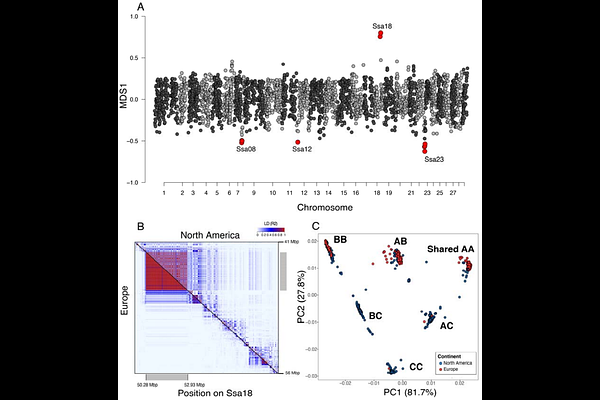Large haplotypes linked to climate and life history variation in divergent lineages of Atlantic salmon (Salmo salar)

Large haplotypes linked to climate and life history variation in divergent lineages of Atlantic salmon (Salmo salar)
Lehnert, S. J.; Kess, T.; Bentzen, P.; Barson, N.; Lien, S.; Dempson, J. B.; Bradbury, I. R.
AbstractAdvances in sequencing are revealing that linked genomic architectures, enabling the evolution of co-adapted alleles at multiple loci, often shape complex phenotypes. Several recent studies have identified such architectures (e.g., chromosomal rearrangements and supergenes) contributing to adaptation or divergence across diverse species, from plants to mammals. Specifically, within Atlantic salmon (Salmo salar), genomic studies are revealing large haplotypes and structural variants that may underpin local adaptation in the species. Using data from >4000 individuals from 134 locations spanning the North Atlantic Ocean, we identify a large (~3-Mbp) genomic region on Ssa18 showing patterns of differentiation and linkage disequilibrium indicative of a large haplotype block containing three divergent haplotypes (herein A, B, and C haplotypes). In Europe, haplotypes A and B were common, whereas A and C were more common within North America, suggesting a shared \"ancestral\" A haplotype, with different continent-specific alternative haplotypes. Data support independent origins of divergent haplotypes in each continent, as well as signals of trans-oceanic introgression of haplotypes. Haplotype frequency is strongly associated with latitude, climate, and life history (smolt age); however, the strength and direction of these relationships vary across continents. Overall analyses were consistent with other studies that identify chromosomal rearrangements; however, long read sequence data could not confirm evidence of a structural variant, although an ancestral fusion polymorphism may explain the formation and maintenance of the observed haplotypes. Our study contributes to ongoing efforts to understand the evolutionary role of linked genomic architecture in Atlantic salmon and its significance in salmonid diversification.